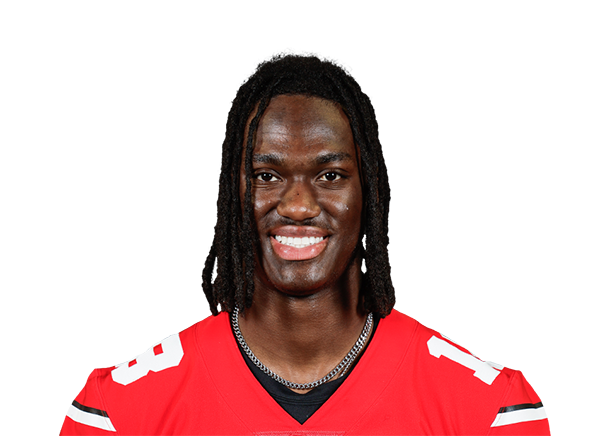2016 NFL Draft: College WR AIR
Last offseason, I analyzed the 2015 wide receiver class using fellow DLF writer Eric Hardter’s AIR metric. You can find that article here. And for those of you looking for detail on the AIR score methodology, I have you covered here as well. This year, I will bring in some more historical data and overlay this year’s class to provide even better context to what we are seeing.
Youth Has No Age
While Pablo Picasso gets credit for the quote, it is Jon Moore of Rotoviz who has decided to try and refute the claim. His work with breakout ages for draft classes (here is 2016) is just one example of applying the age of prospects against their college production. He also keeps an age database where I sourced some of the 2016 class from, so bookmark this link as well.
This year, I decided to chart the full database I have to analyze AIR production by age to see where the 2016 class fell. The red dots below represent the various years of production from this year’s wide receiver class. Ideally, you want to see them in the upper left (“Shooting Stars”) and the upper right (“Cash Cows”) quadrants where they are performing above a 1.20 AIR score. Here is a brief description of each quadrant:
- Question Marks – Players who are under the age of 21 and score below a 1.20 AIR in that season. These players are still developing but are struggling to produce when given opportunity.
- Shooting Stars – Wide receivers below the age of 21 with a score of a 1.20 AIR or higher for the season. These are early indicators of a strong prospect as they are showing great production with their chances.
- Cash Cows – Receivers are older than 21 and have a 1.20 AIR score or higher that year. The players here are more mature in their evolution but are productive with the targets they are given.
- Dogs – The struggle is real. This quadrant is reserved for receivers over 21 with below a 1.20 AIR score for the year. Receivers are further in their physical development but are still producing at a lower rate during the measured timeframe.
[am4show have=’g1;’ guest_error=’sub_message’ user_error=’sub_message’ ]

Three players have two years of Shooting Star production: Tyler Boyd, Leonte Carroo and Pharoh Cooper. Only 17 other players in the last ten years have managed the feat and of them, only two have not become starters for an NFL team. That consistent success bodes well for their futures.
On the flip side, two receivers in this year’s class have multiple years of Dog level scoring: Keyarris Garrett and Daniel Braverman. There are few examples of success coming out of this group with Donnie Avery and Kendall Wright perhaps the most prominent. This is a red flag for those of us looking for the mid-round rookie picks at the position.
If We Chase Perfection, We Can Catch Excellence
My arms hurt stretching for this quote but Vince Lombardi was nothing if not inspirational. Part of the process with determining AIR scores is looking at player targets to normalize for those getting a disproportionate share relative to their production. Therefore, we want to see if they are catching excellence…there it is, we’ve linked them.
Terrible reach aside, there is a relationship between target volume and AIR score among college receivers. Looking at the chart below, you can see a wider disparity in AIR scores when there are fewer targets. When analyzing the 0 to 50 and the 51 to 100 target ranges, the standard deviations are 0.23 and 0.18 respectively. Whereas, when I looked at ranges above 100 targets, the standard deviation of the AIR score stayed a consistent 0.13 for all groups. This shows that as a receiver exceeds 100 targets, we can be more certain that his score is indicative of his talent as opposed to a potential deviation due to small sample. Those deviations are usually a result of some big plays (touchdowns or long yardage catches) that skew the remaining sample.

As we analyze the 2016 wide receiver draft class, I will highlight seasons where a player has failed to surpass 100 targets for that season, which should give some pause to their performance (either positive or negative). My recommendation is to place more weight on seasons with target counts closest to 100 in the case of players who never managed the feat and to treat all 100+ target seasons equally in your assessment of the prospect.
How did the draft class fair?
Let’s just lay it out there and provide the full AIR scores for all seasons scored. Below you find all wide receivers that I chose based on draft rankings from various sites. If there is someone missing, let me know and I can provide numbers in the comments.

Those highlighted in red are AIR scores where the targets were under 100. To see the full data for the class along with the 2015 game logs I charted, see this link. Let’s talk about who rose and fell based on this exercise.
Stock Up
Leonte Carroo, WR Rutgers – The second and third tiers of receivers in this draft are vast and muddled. Carroo is a clear winner when assessing his college production, even considering the fact that he never crossed 100 targets in a season. Some of that is due to injury and suspension, but he did have a 94 target season in 2014, which is awfully close. Even in that year, his 1.36 score is over one standard deviation above the mean. He is a guy I have been grading as a mid-first round rookie draft option that can be had in the late first and even early second.
Tyler Boyd, WR Pittsburgh – While no one is making any Avoid the Boyd commercials (yet), Tyler has been getting downgraded despite the fact he was a contender for the top receiver going into 2015. Fellow DLF writer Nick Whalen and I discussed the circumstances of his 2015 slippage in the FilMetrx Podcast, so I put more weight on his previous seasons, which are very impressive. I grabbed him at 1.08 in a recent DLF writer’s mock draft, a steal in my opinion.
Pharoh Cooper, WR South Carolina – Cooper could be destined for a slot receiver role, but that is no longer a death sentence in today’s NFL. He has shown big play ability (27% of receptions in 2015 for 20+ yards) and with two seasons of AIR scores at 1.20 or higher before 21 on 100+ targets, he performs at a very high level. Cooper has an ADP of 16 in DLF mock drafts, a price I am ecstatic to pay for a consistent producer.
Roger Lewis, WR Bowling Green – If you do not know his background, google it. The former four star recruit had a decent 2014 where he was barely 21 by season’s end, teetering on the Question Mark/Dog line. In 2015, however, he rocketed up to the Cash Cow quadrant, buoyed by 16 receiving touchdowns (although Bowling Green threw for 47) and 66% catch rate on 128 targets. Right now, Lewis is in the early third round conversation, which is well worth it for a player this productive and has just two years of college football under his belt.
Hunter Sharp, WR Utah State – Of the prospects who are getting little recognition, Sharp has been one of the most impressive. He has two seasons over 1.20 at 20.7 and 21.7 years of age, keeping him entrenched in the quadrants we want to mine for talent. His game was less downfield strikes (17% of catches in 2015) and more centered around strong hands (68% and 65% catch rates in 2015 and 2014) with a penchant for scoring (he is 43% of the receiving touchdowns at Utah State the last two years). Sharp has real speed and explosiveness, which wasn’t on display at Utah State, and could light up the combine and become a regular option in four round rookie drafts soon enough.
Honorable Mentions: Michael Thomas (both), Paul McRoberts
Stock Flat
Rashard Higgins, WR Colorado State – Higgins had a very strong 2014 with Garrett Grayson at the helm and turned in a very respectable 2015 while adjusting to many poor throws. Want proof? He caught 71% of his targets in 2015 while everyone else caught just 56% of their passes. The reason I did not think his stock rose with this analysis was the fact his question marks have never been about production, but his frame instead. Higgins has been a mid-second round rookie pick and I would keep him there, just shuffling some of the receivers above and below him.
Laquon Treadwell, WR Mississippi – Another player whose production did not alter my perception of him much, Treadwell still wanders in unknown territory. The youth has him firmly planted in the Question Mark quadrant and his 2015 AIR score essentially hits the mean figure (1.15) over the last 11 years. The players who have shown mean levels of production vary from the great (Dez Bryant, Odell Beckham Jr.) to the not so great (Markus Wheaton, Earl Bennett). Treadwell’s combine and NFL draft results will be more influential for me than his college production in determining if he deserves the top spot.
Corey Coleman, WR Baylor – Coleman falls into the Higgins camp in terms of where questions arise. No one doubts his college contributions and the numbers suggest much of the same. Even though his 2014 to 2015 AIR scores dropped (from 1.39 to 1.23), Coleman went from 88 to 117 targets and had poor quarterback play. The questions remain about his size and ability to play outside in the NFL, which is not something we can answer here.
Stock Down
Tajae Sharpe, WR UMass – This has to do with his current ADP (15.5) relative to what we see here. In 2015, the surface stats look nice (111 catches, 1,319 yards), but it was on 176 targets, among the highest recorded in the last 11 years. While his AIR scores have never been too poor and he is still just 21, there are players I would have above him right now. Consider this a slight downgrade.
Aaron Burbidge, WR Michigan State & Quinshad Davis, WR North Carolina – A pair of third round receivers in recent mock drafts, the pair have done little recently to suggest they will have any production in the NFL. Burbidge even has a season of 100+ targets and struggled to out-produce his teammates (with Connor Cook at quarterback) at age 22. Davis has one season of strong production (1.49 in 2013), but it was on just 69 targets and was based on a ten touchdown season, his combined number in the last two years. There are better options in this spot.
Charone Peake, WR Clemson & Geronimo Allison, WR Illinois – These two receivers have had some glimmers of hope from NFL Draft analysts as potential late round prospects. Neither has had much of an opportunity but are vertical threats who have struggled to make an impact. They will be clear avoids for me.
*All pre-2015 target data was via Football Study Hall and all college stats via College Football Reference
[/am4show]
- Bowl Game Previews: CFB Playoff Semifinals - December 28, 2018
- The Narrative Fallacy and How it Compels Us - May 13, 2017
- 2017 NFL Draft – College Wide Receiver AIR - April 27, 2017

































































